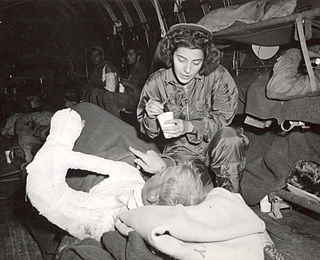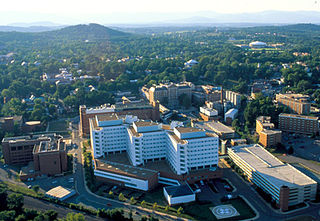
Emergency medical services (EMS), also known as ambulance services or paramedic services, are emergency services that provide urgent pre-hospital treatment and stabilisation for serious illness and injuries and transport to definitive care. They may also be known as a first aid squad, FAST squad, emergency squad, ambulance squad, ambulance corps, life squad or by other initialisms such as EMAS or EMARS.

The Twenty-fifth Amendment to the United States Constitution deals with presidential succession and disability.

A paramedic is a healthcare professional trained in the medical model, whose main role has historically been to respond to emergency calls for medical help outside of a hospital. Paramedics work as part of the emergency medical services (EMS), most often in ambulances. They also have roles in emergency medicine, primary care, transfer medicine and remote/offshore medicine. The scope of practice of a paramedic varies between countries, but generally includes autonomous decision making around the emergency care of patients.

An emergency department (ED), also known as an accident and emergency department (A&E), emergency room (ER), emergency ward (EW) or casualty department, is a medical treatment facility specializing in emergency medicine, the acute care of patients who present without prior appointment; either by their own means or by that of an ambulance. The emergency department is usually found in a hospital or other primary care center.
A trauma center, or trauma centre, is a hospital equipped and staffed to provide care for patients suffering from major traumatic injuries such as falls, motor vehicle collisions, or gunshot wounds. A trauma center may also refer to an emergency department without the presence of specialized services to care for victims of major trauma.

The Presidential Service Badge (PSB) is an identification badge of the United States Armed Forces which is awarded to members of the U.S. Army, U.S. Navy, U.S. Air Force, U.S. Space Force, U.S. Marine Corps, and U.S. Coast Guard as well as other members of the uniformed services, such as the U.S. National Oceanic and Atmospheric Administration Commissioned Corps and the U.S. Public Health Service Commissioned Corps, who serve as full-time military staff to the president of the United States.

The David Grant USAF Medical Center (DGMC) at Travis Air Force Base in Fairfield, California, is the United States Air Force's largest medical center in the continental United States and serves military beneficiaries throughout eight western states. It is a fully accredited hospital with a National Quality Approval gold seal by the Joint Commission, and serves more than 500,000 Department of Defense and Department of Veterans Affairs Northern California Health Care System eligible beneficiaries in the immediate San Francisco–Sacramento vicinity from 17 counties covering 40,000 square miles. Originally known as Travis Air Force Base Hospital, DGMC was renamed in 1966 in honor of David Norvell Walker Grant, the first Surgeon General of the United States Army Air Corps and United States Army Air Forces.

A Disaster Medical Assistance Team (DMAT) is a specialized group under the National Disaster Medical System (NDMS), part of the U.S. Department of Health and Human Services. These teams are composed of professional medical personnel including physicians, physician assistants (PA), nurses, paramedics, pharmacists, and logistical and administrative support staff. DMATs are deployed to provide rapid-response medical care, support hospitals with excess patient loads, and engage in patient triage and emergency care during significant incidents such as natural disasters, terrorist attacks, disease outbreaks, and national special security events.

The University of Chicago Medical Center is a nationally ranked academic medical center located in Hyde Park on the South Side of Chicago. It is the flagship campus for The University of Chicago Medicine system and was established in 1898. Affiliated with and located on The University of Chicago campus, it also serves as the teaching hospital for Pritzker School of Medicine. Primary medical facilities on campus include the Center for Care and Discovery, Bernard A. Mitchell Hospital, and Comer Children's Hospital.

R Adams Cowley Shock Trauma Center is a free-standing trauma hospital in Baltimore, Maryland and is part of the University of Maryland Medical Center. It was the first facility in the world to treat shock. Shock Trauma was founded by R Adams Cowley, considered the father and major innovator of trauma medicine.

Emergency medical services in France are provided by a mix of organizations under public health control. The central organizations that provide these services are known as a SAMU, which stands for Service d’aide médicale urgente. Local SAMU organisations operate the control rooms that answer emergency calls and dispatch medical responders. They also operate the SMUR, which refers to the ambulances and response vehicles that provide advanced medical care. Other ambulances and response vehicles are provided by the fire services and private ambulance services.

University of Missouri Health Care is an American academic health system located in Columbia, Missouri. It's owned by the University of Missouri System. University of Missouri Health System includes five hospitals: University Hospital, Ellis Fischel Cancer Center, Missouri Orthopedic Institute and University of Missouri Women's and Children's Hospital — all of which are located in Columbia. It's affiliated with Capital Region Medical Center in Jefferson City, Missouri. It also includes more than 60 primary and specialty-care clinics and the University Physicians medical group.
Spartanburg Regional Healthcare System(SRHS) is one of South Carolina's largest healthcare systems. SRHS draws patients primarily from the areas of Spartanburg, Cherokee, Union, and Greenville counties (all located in the Piedmont region of South Carolina) as well as Rutherford and Polk counties (located in western North Carolina). Spartanburg General Hospital was organized under the authority of the South Carolina General Assembly in 1917 and officially became the Spartanburg Regional Health Services District, Inc., a political subdivision of the State of South Carolina, by the charter granted by the secretary of state of South Carolina on May 1, 1995.

A flight nurse is a registered nurse who specialises in the field of providing comprehensive pre-hospital, emergency critical care, and hospital care to a vast scope of patients. The care of these patients is generally during aeromedical evacuation or rescue operations aboard helicopters, propeller aircraft or jet aircraft. On board a rescue aircraft you would find a flight nurse accompanied by flight medics and respiratory practitioners, as well as the option of a flight physician for comprehensive emergency and critical transport teams. The inclusion of a flight physician is more commonly seen in pediatric and neonatal transport teams. A critical care flight nurse must be able to deal with all age groups with broad critical emergencies. With no physicians on site the nurses scope of practice is expanded. The critical care experience is transferred over to a flight nurse with impacting factors such as altitude and changes in pressure, gravitational forces, and weather. Some patients may experience exacerbation because of factors related to the cabin environment including hypoxia, limited mobility, gas expansion, and risk of injury related to turbulence and resources with definitive care are limited. Aeromedical evacuation crews coordinate with other organizations to plan for the safe and timely care and evacuation of patients. Crews must be prepared for patients with trauma and mental health illnesses.

The University of Virginia (UVA) Health System is an academic health care center associated with the University of Virginia in Charlottesville. The health system includes a medical center, school of medicine, school of nursing, and health sciences library. The health system provides inpatient and outpatient care and patient education and conducts medical research and education.

McLaren Flint is a nonprofit, 378 bed tertiary teaching hospital located in Flint, Michigan. McLaren is affiliated with the Michigan State University College of Human Medicine's medical residency programs, including family medicine, internal medicine, general surgery, orthopedic surgery and radiology. McLaren also maintains a hematology/oncology fellowship program in partnership with Michigan State University and is sponsoring a surgical oncology fellowship program. McLaren Flint is a subsidiary of McLaren Health Care Corporation.

The physician to the president is the formal and official title of the physician who the president of the United States chooses to be their personal physician. Often, the physician to the president also serves as the director of the White House Medical Unit, a unit of the White House Military Office responsible for the medical needs of the president of the United States, vice president, White House staff, and visitors. The physician to the president is also the chief White House physician.

Healthcare in Belgium is composed of three parts. Firstly there is a primarily publicly funded healthcare and social security service run by the federal government, which organises and regulates healthcare; independent private/public practitioners, university/semi-private hospitals and care institutions. There are a few private hospitals. Secondly is the insurance coverage provided for patients. Finally, industry coverage; which covers the production and distribution of healthcare products for research and development. The primary aspect of this research is done in universities and hospitals.

Air medical services are the use of aircraft, including both fixed-wing aircraft and helicopters to provide various kinds of medical care, especially prehospital, emergency and critical care to patients during aeromedical evacuation and rescue operations.
Sentara Northern Virginia Medical Center (SNVMC) is a 183-bed, not-for-profit community hospital serving Prince William County and its surrounding communities. Potomac Hospital, an independent, non-profit community hospital, merged with Sentara Healthcare in December 2009 and is now known as Sentara Northern Virginia Medical Center (from April 16, 2012). The SNVMC market has experienced tremendous growth since the opening of the hospital in 1972.



















